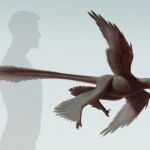feathers
This newly discovered feathered dinosaur, Changyuraptor yangi, was built like a modern airplane. Illustration by S. ABRAMOWICZ, DINOSAUR INSTITUTE, NHM.
Photo of fossil by: Luis Chiappe Dinosaur Institute, NHM as published in the USA Today
The discovery of this non-avian dinosaur, Changyuraptor yangi, that lived 125 million years ago suggests that flight came before birds. The fossil was discovered in the Liaoning Province of northeastern China by Luis Chiappe from the Natural History Museum in Los Angeles, CA. At nearly 4 feet long, it is the largest so-…
The ecology of antibiotic resistance on farms is complicated. Animals receive antibiotic doses in their food and water, for reasons of growth promotion, disease prophylaxis, and treatment. Other chemicals in the environment, such as cleaning products or antimicrobial metals in the feed, may also act as drivers of antibiotic resistance. Antibiotic-resistant organisms may also be present in the environment already, from the air, soil, or manure pits within or near the barns. Ecologically, it's a mess and makes it more difficult to attribute the evolution and spread of resistance to one…
tags: evolutionary biology, paleontology, taphonomy, plumage color, feathers, color, melanin, eumelanin, phaeomelanin, dinosaurs, theropod, paravian, avialae, fossils, Anchiornis huxleyi, ornithology, birds, researchblogging.org,peer-reviewed research, peer-reviewed paper
New research reveals that recently-described 155-million-year-old Anchiornis huxleyi,
a woodpecker-like dinosaur the size of a modern-day domesticated chicken,
had black-and-white spangled wings and a rusty red crown.
Image: Michael DiGiorgio, Yale University [larger view]
Fig. 4. Reconstruction of the plumage color of…
National Geographic should have a 3-D animation up soon
The pursuit of accurate dinosaur colours just turned into a race, and a heated one at that. Just last week, I wrote about a group of scientists who claimed to have accurately identified the colours of some feathered dinosaurs by microscopically analysing three fossils. According to that study, Sinosauropteryx had a tail covered in ginger stripes. Now, another group have revealed the palette of an entire dinosaur, Anchiornis. This tiny predator had a dark grey body and the limbs bore long, white feathers tipped with black spangles. Its…
tags: evolutionary biology, fossils, feathers, plumage color, color, dinosaurs, theropods, Sinosauropteryx, Sinornithosaurus, birds, Confuciusornis, melanosomes, phaeomelanosomes, eumelanosomes, keratinocytes, SEM, scanning electron microscopy, 10.1038/nature08740, researchblogging.org, peer-reviewed research, peer-reviewed paper
Reconstruction of two Sinosauropteryx, sporting their orange and white striped tails.
Artwork by Chuang Zhao and Lida Xing [larger view]
DOI: 10.1038/nature08740
While looking at museum dioramas that feature dinosaurs, I often overhear people asking "How do they…
What happens when you find a feathered dinosaur that really isn't meant to have feathers? That's the question set by a spectacular new fossil that adds a confusing dimension to the origin of feathers.
The concept of dinosaurs with feathers is no longer surprising. Birds certainly have them and they are now considered to be living dinosaurs. The infamous Velociraptor and its relatives were covered in plumes, which ranged from the simple quills of Sinosauropteryx to the flight-capable plumes on Microraptor's four wings. We know about these prehistoric feathers through the beautiful fossil…
Beipaiosaurus was among the strangest of dinosaurs. It looked like a fusion of body parts taken from several other species and united in the unlikeliest of proportions. It had a stocky body, long arms adorned with massive claws, a long neck topped by an incongruously small head, and a beaked mouth. Bizarre as this cocktail of features is, it's the animal skin that has currently warrants attention.
Fossils of Beipaiosaurus include impressions of its skin and these clearly show long, broad filaments clumped around its head, neck, rump and tail. They are feathers, but most unusual ones. Traces…
Some of you may have noticed some changes to the front page of Sb and some new photos in the category sections, and I'm proud to say that one of my photos made the cut for this week under the Life Science section. Hence, I've decided to post the "full" version of the photo here. In case anyone's unfamiliar with the animal, it's an Indian Peafowl, Pavo cristatus, although not everyone could merely enjoy the aesthetics of the striking display of the male bird. Writing to Asa Gray, Charles Darwin once related;
...I remember well the time when the thought of the eye made me cold all over, but I…
tags: feathers, dinosaurs, humor, cartoon
En el tÃpico rito funerario del Jurásico tardÃo unos dinosaurios terópodos depositan plumas sobre el cuerpo de un compañero justo antes de la momificación. Desfortunadamente no pensaron en los paleontólogos del futuro.
Image: The Scientific Cartoonist [larger view].
I am sure that one of my readers, Jerry Harris, will especially like this cartoon.
Thanks Chris!
When I was first becoming acquainted with dinosaurs during the latter half of the 1980's, the standard "rule" for theropod dinosaurs was that as they grew bigger through the course of time their heads became more robust and their arms grew smaller. Just comparing the Jurassic predator Allosaurus with the Cretaceous Tyrannosaurus rex (numerous pictures of both filling the books I constantly begged my parents to purchase for me) seemed to confirm this, but there was always one very special set of fossil remains that seemed to contradict the prevailing trend. Hung up in the corner at the…
tags: researchblogging.org, velociraptor, Dromaeosauridae, dinosaur, feathers, paleontology, evolution
Velociraptor skull.
Velociraptors were small dinosaurs, weighing only about 15kg and approximnately 1.5m long.
Image: M. Elison, AMNH. [larger view]
According to a research paper that was published late last week, the Velociraptor probably had feathers. A closer look at a fossil Velociraptor ulna (forearm) that was found in Mongolia in 1998 revealed a series of small bumps along its length. These bumps are known as "quill knobs" because they are found in most modern birds where they…
